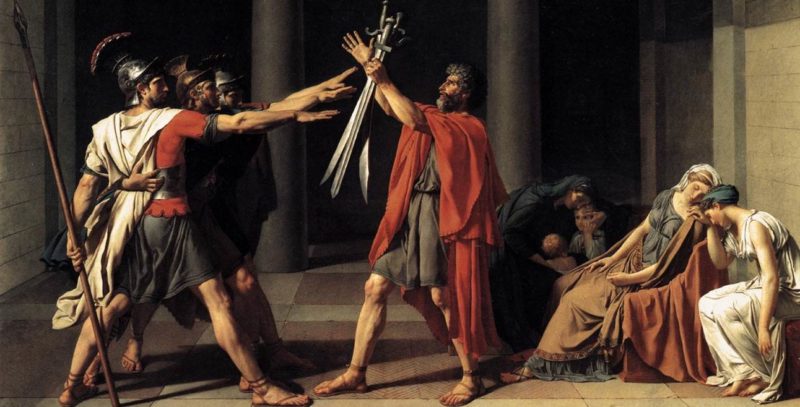We explain what Neoclassicism was, what its general characteristics are and how it was applied in other artistic disciplines.
What is Neoclassicism?
Neoclassicism was an artistic and intellectual movement that originated in Rome in the 18th century and then spread throughout Europe . He opposed the styles that preceded him, such as Rococo and Baroque , which he considered vain and based on fantasy.
Neoclassicism reflected the political and social reality of a time characterized by violent clashes between classes , such as the French Revolution (1789). It accompanied the beginning of a new era called The Age of Enlightenment , which alluded to the clarity of knowledge and reason, to "illuminate" the ignorant humanity of the time.
The period of neoclassicism resulted in the transition from the old regime to a new one, based on the diffusion of knowledge from science and reason . At the beginning of the 19th century and before the fall of Napoleon Bonaparte (1815), the neoclassical movement gave rise to romanticism , which lasted until the 20th century and was based on emotions , individuality and freedom .
See also: Bourgeois revolutions
Characteristics of Neoclassicism

Neoclassical works were serious, with a moderate emphasis on emotions, and created from the simplicity of technique . Through precise representations, both in the detail of the faces and the settings, and credible attitudes, the works expressed situations of the society of the time.
Among the main characteristics of neoclassicism, it stands out that:
- It turned out to be the art of the century of revolutions and it sought to achieve order and harmony from the moral point of view.
- It involved the decorative and visual arts, literature , theater , music, and architecture .
- He broke with the crowded baroque style , in search of a more rational and faithful to reality.
- He transformed society through art, with new enlightened approaches based on science and knowledge.
Neoclassicist architecture
 Neoclassical architecture was characterized by greatness in its scale and the use of columns . However, simplicity prevailed with respect to the ancient Greek or Roman styles, which were loaded with a large number of ornamental elements in order to show off. The neoclassical buildings were imposing and simplistic at the same time.
Neoclassical architecture was characterized by greatness in its scale and the use of columns . However, simplicity prevailed with respect to the ancient Greek or Roman styles, which were loaded with a large number of ornamental elements in order to show off. The neoclassical buildings were imposing and simplistic at the same time.The neoclassical style was very popular in the architecture of Europe and the United States , especially with buildings considered icons, such as the Arc de Triomphe in Paris, the Brandenburg Gate in Germany, the Capitol in Washington DC and the Baltimore Basilica in Maryland. U.S).
Neoclassical painting
Neoclassicist works presented clean and perfect lines , which avoided showing the stroke of the brush. The settings and characters were represented in realistic situations, to convey the intellectual ideas and conjunctural situations of the time.The painting neoclasicista sought to differentiate themselves from the styles that preceded it , as the Rococo was characterized by opulence, elegance and the use of intense colors, and that was flamboyant baroque, gloomy and dark.
Both Rococo and Baroque art alluded to fantasy situations and naked goddesses. Neoclassicist works, without renouncing nudes, opposed this utopian art and stood out for representing reality and morality .
The neoclassical was based on a complete symmetry and statics that tried to bring reason to art, and expressed the logic and skepticism of the time in the works. It was used light clear and very little color. In this period the landscapes became fashionable and the works showed the cities and the customs of the time.
Neoclassical art was influenced by Greek and Roman mythology , with which it shared certain values . Mythological thinkers were examples of moral behaviors to follow, far from lust, corruption or luxury.
Among the main representatives of neoclassical painting, the following stood out:
- Antoine-Juan Gros (1771-1835), France .
- Anne-Loui Girodet-Trioson (1767-1824), France.
- Jacques-Louis David (1771-1835), France.
- Anton Rafael Mengs (1728-1779), Spain .
- Juan Antonio Ribera (1997-1860), Spain.
- Andrea Appiani (1754-1817), Italy .
- Angelika Kauffman (1741-1807), Germany .
- Leo von Klenze (1784-1864), Germany.
Neoclassical literature
 Neoclassical literature showed a deep interest in spreading knowledge , based on reason and science. He pursued didactic, moralistic aims and rejected the excess of the baroque imagination. It was influenced by the classical ideas of great thinkers and philosophers, such as Aristotle and Socrates .
Neoclassical literature showed a deep interest in spreading knowledge , based on reason and science. He pursued didactic, moralistic aims and rejected the excess of the baroque imagination. It was influenced by the classical ideas of great thinkers and philosophers, such as Aristotle and Socrates .Among the neoclassical literary works arises the essay (as a genre to disseminate ideas based on reason), the encyclopedia (as a new genre to disseminate human knowledge in general) and the fable (which aims to leave a teaching or moral).
Among the main representatives of literature were:
- Alexander Pope (1688-1744), England .
- Samuel Johnson (1709-1784), England.
- Jean de la Fontaine (1621-1695), France.
- Jean-Baptiste Poquelin - Moliere (1622-1673), France.
- Pierre Corneille (1606-1684), France.
- Jean Racine (1639-1699), France.
The above content published at Collaborative Research Group is for informational and educational purposes only and has been developed by referring reliable sources and recommendations from technology experts. We do not have any contact with official entities nor do we intend to replace the information that they emit.
Cultural journalist with great interest in education and technological innovation in the classroom. The future passes through technology and it is already here. .
Leave a reply
Your email address will not be published. Required fields are marked *Recent post

Sport: What Is It, Types, Risks, Features, Characteristics and Examples

Dogs: Emergence, Features, Characteristics, Feeding and Breeds

Story: Definition, Elements, Structure, Features and Characteristics

